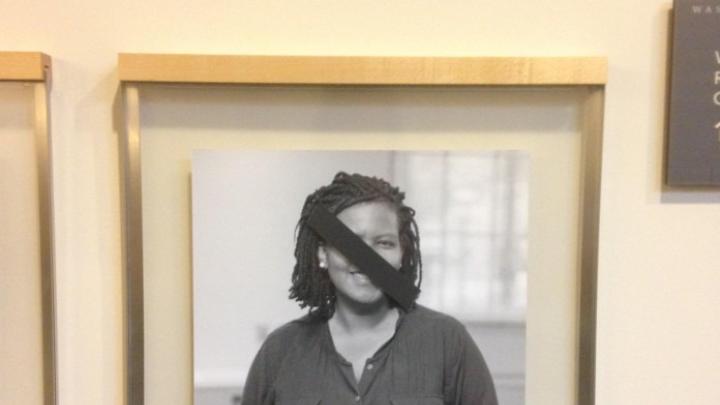Harvard Law School (HLS) affiliates entering Wasserstein Hall Thursday morning found a startling scene: portraits of every black professor in the school’s history defaced with black tape, an incident University police are investigating as a hate crime. Hours later, President Drew Faust e-mailed the Harvard community on the subject of race, announcing the results of a more than year-long study of diversity and inclusion at the College. These and other developments unfolded in a rapid sequence, as echoes of the student protests at campuses around the country reached Cambridge.
The day before, Faust had stood with dozens of University affiliates who gathered in the Science Center Plaza in solidarity with student activists at Yale, the University of Missouri, and elsewhere. Invoking these and other demonstrations, Faust called the University community to action in her message Thursday afternoon: “We have much work to do to make certain that Harvard belongs to every one of us, that the diversity we strive to achieve also becomes belonging,” she wrote, echoing comments made earlier this year.
Following the HLS incident, Faust wrote a separate statement posted on the Harvard website Friday morning:
We join together as a University in deploring the defacing of portraits of African American faculty at the law school. Such acts of hatred are inimical to our most fundamental values and represent an assault on the mutual respect essential to our purposes as a community of learning and inquiry.
An early advocate of desegregation and a historian of the American South, Faust frequently has used her platform to speak about America’s stained racial legacy. In recent months and years, she has expanded that role amid renewed calls for racial justice on the streets of cities and college campuses across the nation. Student protests came to a head this month, following the resignation of University of Missouri president Tim Wolfe after racist incidents there and widely publicized controversies over racial exclusion (extending from disagreements about culturally insensitive Halloween costumes to matters of faculty diversity and the content of the curriculum) at Yale. Those demonstrations have raised difficult questions about the role that universities should play in censuring insensitive or hateful speech.
Law students and faculty gathered for a meeting Thursday to address the defacement of the portraits. There, Dean Martha Minow acknowledged that the community faces significant problems with racism.
Climenko professor of law Charles Ogletree, one of the those whose portrait was defaced, said in an interview he believes the incident represents constitutionally-protected free speech. “I’m a firm believer in the First Amendment, even for speech that might be ugly or hateful….I don’t think any of these actions are criminally prosecutable. I think they’re freedoms of expression. Nothing was burned or damaged,” he said. “I don’t like it, I’m very unhappy with it, but that happens in a free society….I would like to confront and dialogue with those responsible.”
Student activists have suggested that the Harvard administration has not done enough to address racism at the University. “I’m disappointed in the administration’s response every day up to and including yesterday,” said Michele Hall, a second-year law student who wrote a widely circulated blog post on Thursday’s incident at the school.
“Yesterday was an anomaly because it was so overt, but students of color are working through these issues every day,” she continued. “The law is taught to us as if it was created in a neutral world by neutral actors and imparted on neutral people….That’s how the entire pedagogy is set up: not to address the issues of marginalization that are at the forefront of the law.”
Student activists have called for structural changes at the law school, including curricular changes that would address racial bias in the law, greater faculty diversity, and an office for diversity and inclusion. The student group Royall Must Fall has called for the removal of the crest of the slave-owning Royall family from the school’s official seal. (Isaac Royall Jr.’s will endowed the first faculty chair at the school.) “Physical symbols are an expression of who we are and what we value,” the group wrote in the Harvard Law Record. “The most ubiquitous of these symbols, the seal—which adorns all of our buildings, apparel, stationery, and diplomas—honors a slaver and murderer.” (The controversy echoes similar issues at Yale, which is considering whether one of its undergraduate residences should be named after alumnus John C. Calhoun, and at Princeton, where students have objected to the naming of a residence hall and a school after Woodrow Wilson, who served as president of the institution.)
At the College, student advocates have expressed similar concerns—some of which have been echoed officially. “Harvard College’s aspirations have always run ahead of its realities,” states the report of the College Working Group on Diversity and Inclusion. The working group was established in 2014; its findings were announced by Faust on Thursday and circulated to students by College dean Rakesh Khurana. The 37-page report recommends areas of improvement for inclusion at the College, including small suggestions such as avoiding “unnecessary markers of social distinction” in the way Harvard distributes services to low-income students, and larger ones, like asking academic disciplines to consider how their methods of inquiry may exclude some groups. Faust plans to appoint a task force to implement the recommendations. (Read the full text of the report here.)
Despite the tensions at the law school and elsewhere on campus, the working group ended on a high note. “The care, respect and thoughtfulness demonstrated by members of the Harvard community inspire us,” the report concludes. “In this critical moment, Harvard must commit and recommit itself to the practices that best reflect our institutional mission and ideals.”








